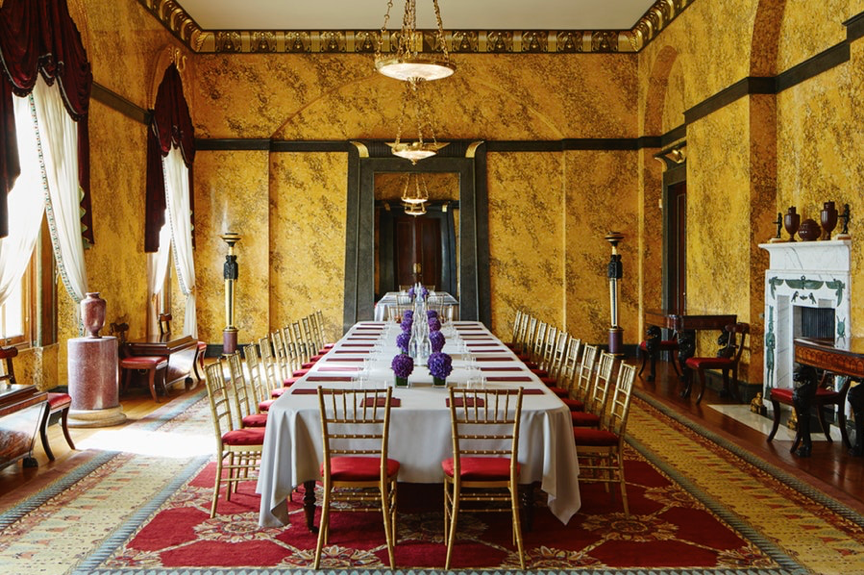
24 Sep Empire Style in Regency Interiors
French influence on Regency interiors
If you live in a Regency house in the UK, you may be interested to know more about the influences on Regency interior design and how much of that survives in your house today. Etons of Bath’s team of interior designers and project managers combine historical expertise, creative ideas and practical experience to renovate and rejuvenate Regency interiors. If you’d like to discuss your home, call us on 01225 639002 today or see our portfolio
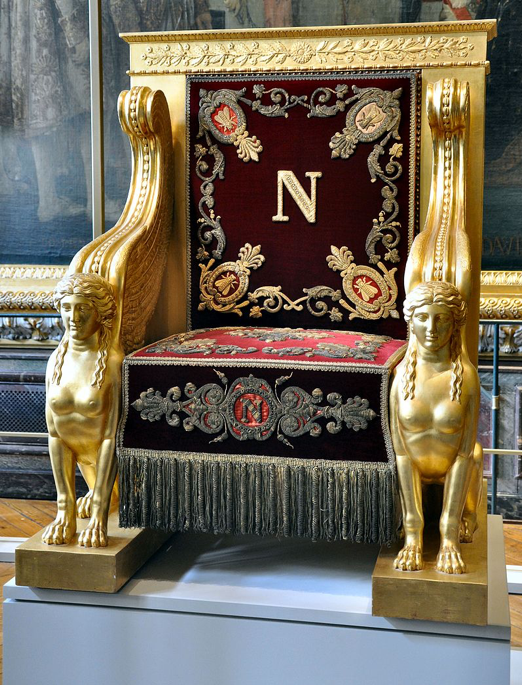
Napoleon’s senate throne
Napoleon Bonaparte had himself crowned emperor of France in 1804. His empire lasted until 1814, and although relatively short-lived, it gave its name to a style which swept through Europe and transformed the fashionable Regency interior in the early 19thcentury.
The influence in Regency interiors was particularly strong in the design of furniture, generally fashioned from mahogany or ebony and featuring elaborate brass mounts or gilded carvings, that drew their influence from the styles of antiquity. Gleaming golden swans, winged lions, sphinxes and sacrificial ram’s heads all imparted an exotic and ostentatious grandeur to the work of the fashionable decorators, and none were more fashionable or influential than the Parisian partnership of Percier and Fontaine, the foremost exponents of Empire style. Charles Percier and Pierre Fontaine were the Emperor’s official government architects and decorators. They are famed for their work at Malmaison, the Empress Josephine’s house outside Paris.
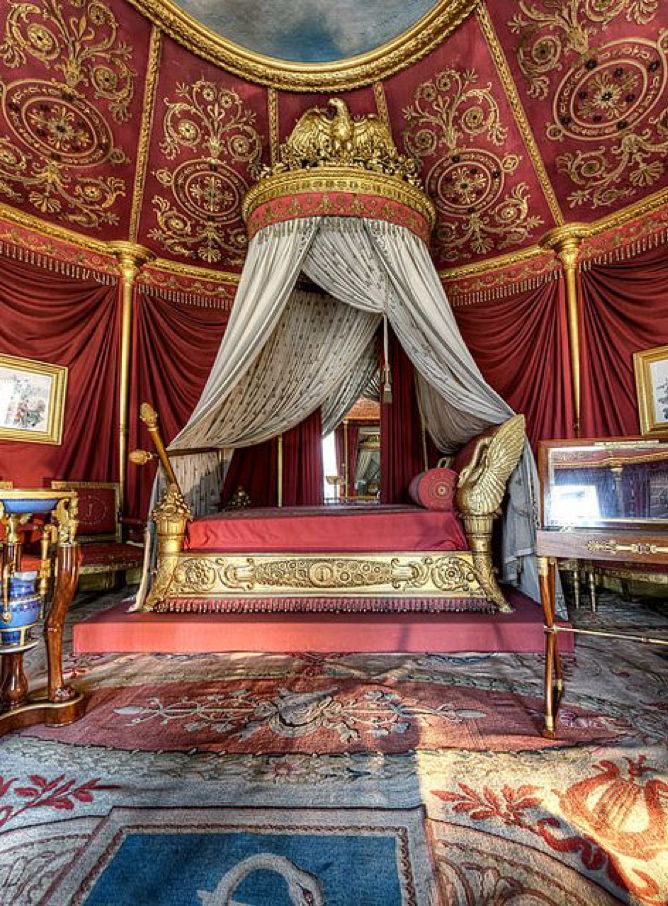
The Empress Josephine’s bedroom at Malmaison, by Percier and Fontaine
Their volume of designs, Recueil des décorations intérieures, published in 1812, became the style bible for an era. ‘Jewellers, goldsmiths, engravers, cabinetmakers and wallpaper manufacturers drew upon the work of Percier,’ observed the Journal du Commerce in 1805, ‘such that it is not unusual to find in a single apartment a tapestry, a clock, a table service, and a woman’s parure in the same design elements.’
In much the same way as Louis XIV, Napoleon surrounded himself with material pomp and grandeur, in order not only to aggrandise himself in the eyes of his subjects, but to stimulate the specialist French manufacturing industries. They had suffered during the French Revolution and Napoleon’s patronage helped to revive the Lyon silk industry, whilst his promotion of extravagant furniture boosted the fortunes of French cabinetmakers.
UK Regency interior design influences
The Napoleonic influence was felt strongly in England and on Regency interior design with the Prince Regent striving to outdo the French Emperor. Of the Regent’s grand plan for a villa on Primrose Hill, connected by a fine street with Carlton House, his London residence, he is reported to have said “It will quite eclipse Napoleon.”
The Blue Velvet Room at Carlton House, designed by Charles Wild in 1816, demonstrates the dominant influence of French Empire style. The furniture is all very much in the manner of Charles Percier. Note the Napoleonic-style laurel wreath on the gold chair back, and the gilded griffins supporting the tables. The design of the sofas resembles that of Napoleon’s Senate throne, pictured above.
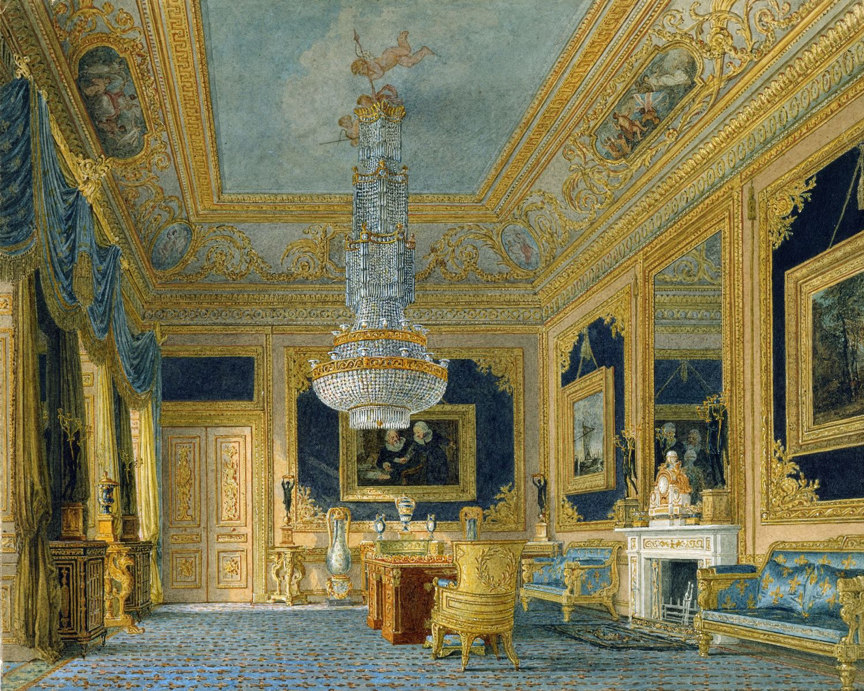
The Blue Velvet Room, Carlton House
Notoriously fickle in his tastes, the Prince Regent changed the décor and Regency interior design of his homes frequently. He tired of the Chinoiserie scheme installed in 1802 in the Saloon at the Royal Pavilion, Brighton, and in 1823 commissioned Robert Jones to create a new scheme heavily influenced by Empire style. The geranium silk drapes with their borders and small motifs brocaded in gold, are typical of the patterns originally favoured by Napoleon, where the design was often composed solely of a “powdering” which consisted of a simple wreath or motif, repeated at regular intervals.
According to Jerzy Kierkuć-Bieliński, exhibitions curator at Sir John Soane’s Museum, Soane also had a great interest in Napoleon, but his attitude was one of admiration, rather than envy. Interested in the Emperor’s programme of urban improvement works in Paris, Soane visited the French capital in 1814 and 1819, and amassed a collection of Napoleonica to aid his Regency interior design projects. He subsequently produced many drawings influenced by what he had seen in Paris.
The dominant theme running through Empire style is Egyptian. It was Napoleon’s Egyptian campaign that gave rise to the wave of Egyptomania that consumed not only France but rapidly crossed the Channel to England. The military campaign may have ended in defeat at the Battle of the Nile, but its style legacy was victorious.
The ancient artefacts discovered in Egypt and the impressive drawings of artist and archaeologist Dominique-Vivant Denon, one of Napoleon’s 200 strong entourage, inspired the new style that conquered Europe and had a profound influence on Regency interiors.
Denon’s works proved highly influential when they were published in a sumptuous two-volume folio edition in 1802, Voyage dans la basse et la haute Egypte(“Journey in Lower and Upper Egypt”) and later in Description de l‘Egypte, published in stages between 1809 and 1828, featuring more than 837 engravings based on his sketches made in Egypt. Denon was the first artist to discover and draw the temples and ruins of ancient Egypt, and to document artefacts found there. He went on to found the museum which became the Louvre. His detailed drawings were a direct influence on the work of Percier and Fontaine.
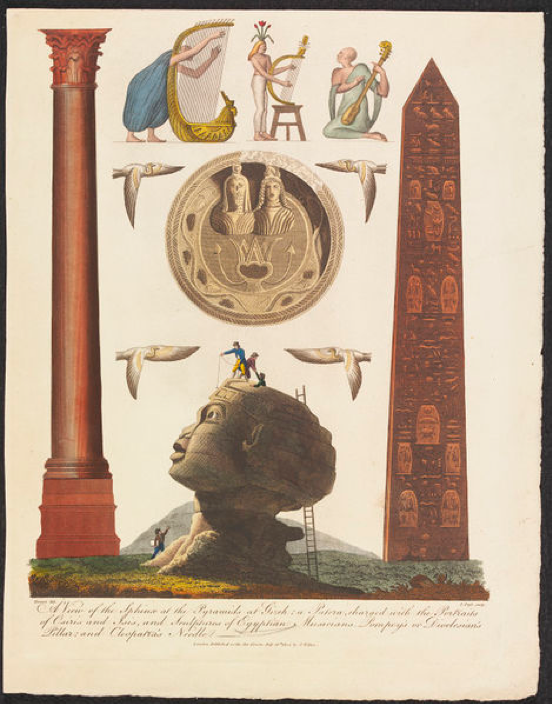
Illustration by Denon from Description de l‘Egypte, in the collection of the V&A
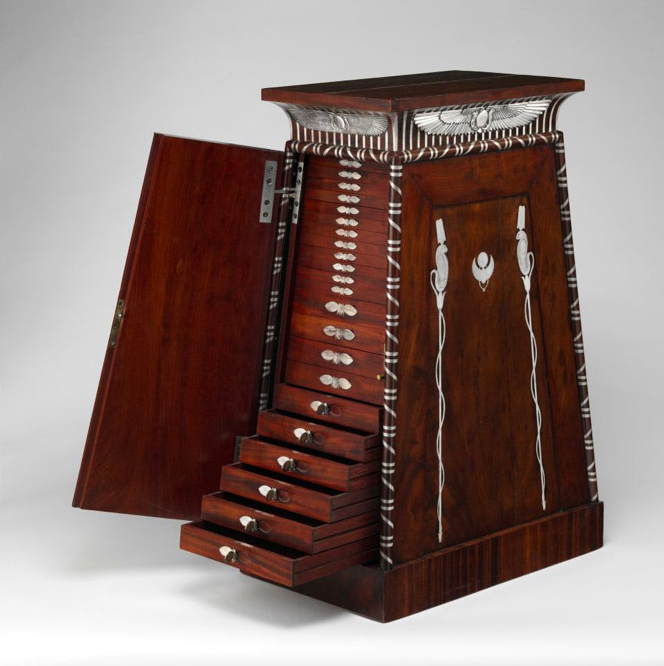
Medal cabinet designed by Charles Percier, after drawings by Dominique Vivant Denon, Metropolitan Museum of Art, New York
Denon’s work fuelled the rise of Egyptomania, a phenomenon that did not escape the satirical pen of cartoonist Thomas Rowlandson.
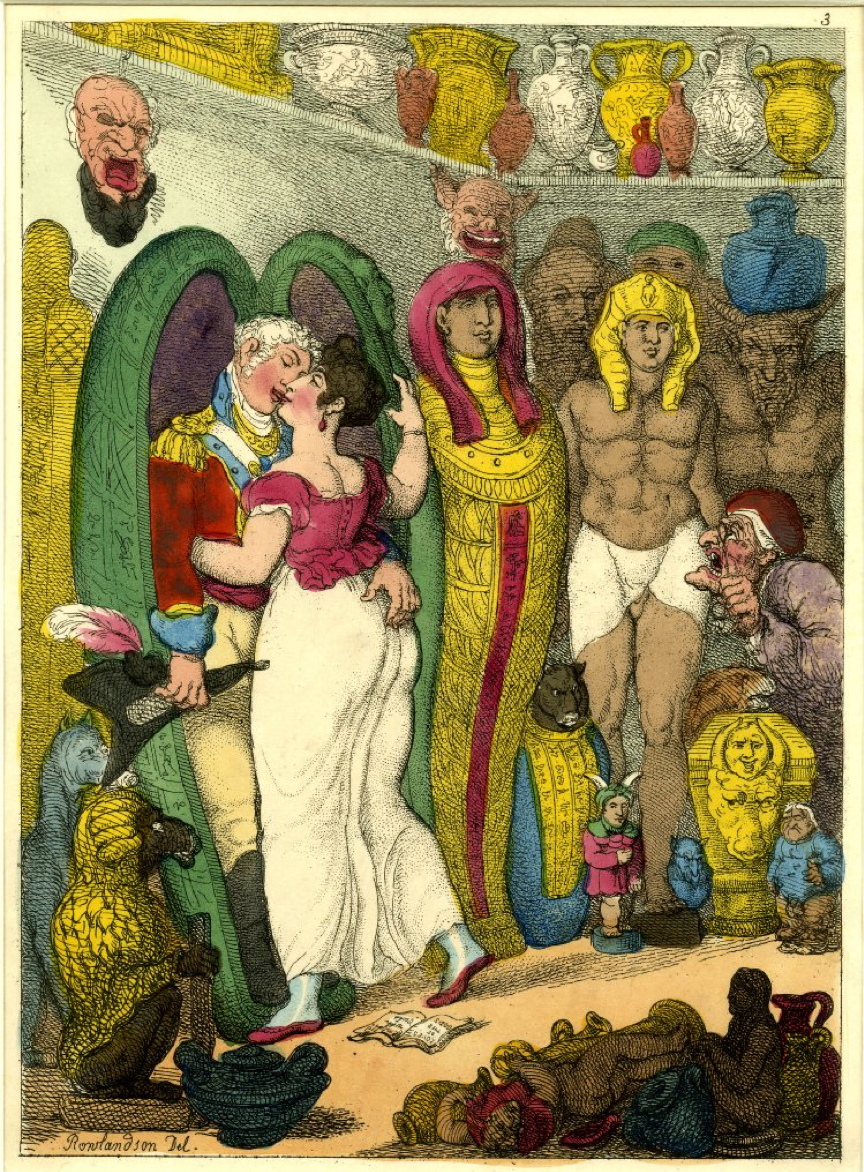
Rowlandson’s cartoon, Modern Antiques, satirises the fashion for collecting Egyptian artefacts, whilst simultaneously mocking several famous personages. The deceased collector and British ambassador at Naples, Sir William Hamilton, is depicted as a ghost, peering at his young wife Emma who is being embraced by her lover Horatio Nelson, standing in a sarcophagus. Looking on are “Egyptianised” caricatures of the Bourbon King and Queen of Naples. Many of Hamilton’s scattered antiquities are copied directly from Denon’s illustrations. When cartoons such as Rowlandson’s lampoon a popular craze, we know that it has become universal.
A letter published in the Morning Chronicle in 1805, complained that “since this accursed Egyptian style came into fashion… my eldest boy rides on a sphinx instead of a rocking-horse, my youngest has a papboat (baby’s feeding dish) in the shape of a crocodile, and my husband has built a water closet in the shape of a pyramid.” This may well be exaggeration but it illustrates how quick manufacturers were to cash in on the latest trends.
The Egyptian Hall in Piccadilly, London, was an exhibition hall built in the ancient Egyptian style in 1812, to the designs of Peter Frederick Robinson. It was the first building in England to be influenced by the Egyptian style, and was partly inspired by Thomas Hope’s Egyptian Room at his house in Duchess Street. The house was open to the public and was featured in illustrations in Hope’s Household Furniture and Interior Decoration(London, 1807)
A rare surviving example of the Egyptian style is the Dining Room at Goodwood House, Sussex.

The Egyptian Dining Room, Goodwood House, Sussex.
Created by Wyatt for the 3rd Duke between 1802 and 1806, it featured detailing copied directly from Denon’s illustrations, notably on the fireplace surrounds. Boarded over in 1906 in favour of an Edwardian neo-Georgian scheme (supposedly at the suggestion of Edward VII) it has now been restored to its former glory.
If you’re interested in restoring or modernising your Regency property, the experts at Etons of Bath can help. Our combination of specialist knowledge of Regency and Georgian buildings with a modern approach to interior design and lifestyle suits buildings of all shapes and sizes. Call us today on 01225 639002 or email charlie@etonsofbath.com




Sorry, the comment form is closed at this time.